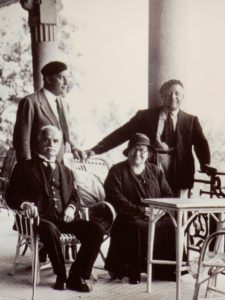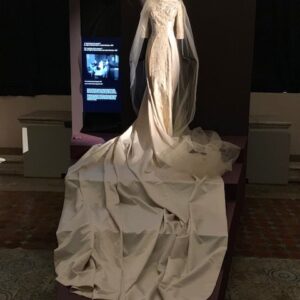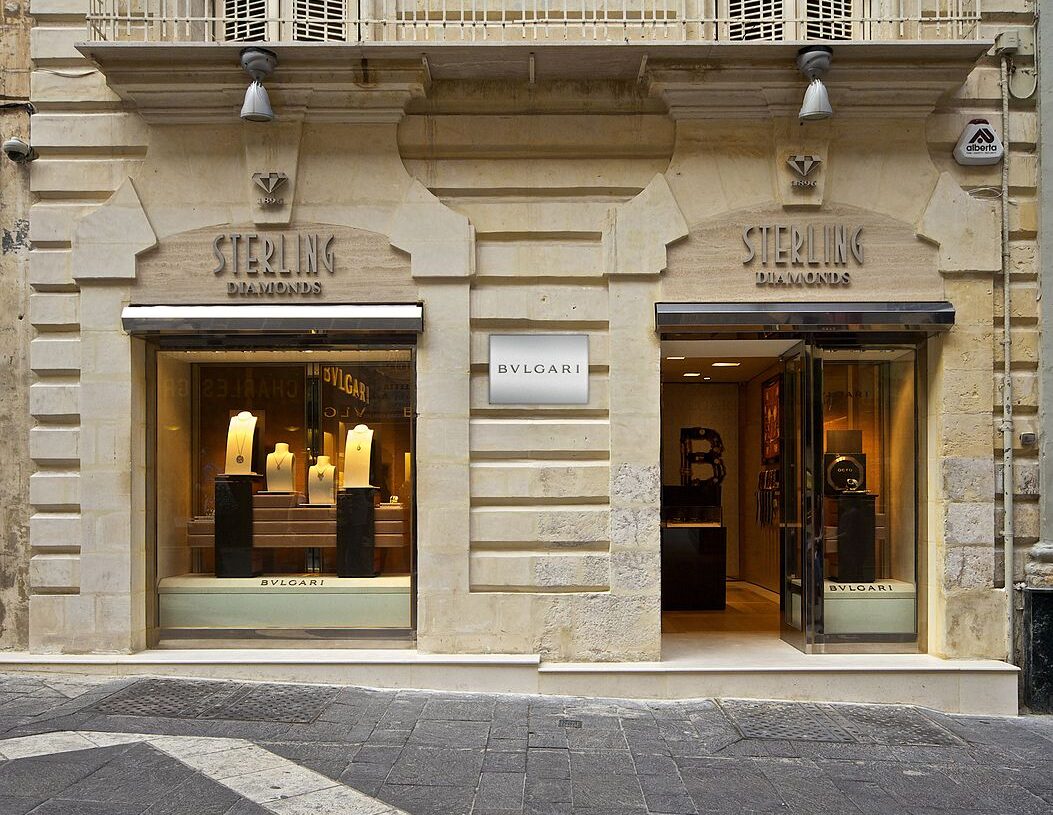My February 2018 article, “Voglia d’Italia’: Collecting Italian Art (1870-1935),” covered the vast and multi-discipline art collection of long-term Roman residents, US diplomat George Washington Wurts and his millionaire wife Henrietta Tower. This was held in two Roman monuments, the Palazzo Venezia and the Vittoriano across the street. “BULGARI: the story, the dream”, is about the Greek-born ‘Roman’ jeweler and the three-generations of his family; the exhibit is being displayed in the same two Roman monuments, Palazzo Venezia and in Castel Sant’Angelo and will run until November 3.
I would say that the story is laid out with family photographs and short videos and accompanied by some silver and jewelry, plus magnificent, mind-boggling haute couture period dresses from heiress Cecilia Matteucci Lavarini’s private collection in Palazzo Venezia; while the dream, a large selection of Bulgari’s dazzling creations from Post-World War II to 1990s, is on display and also accompanied by videos about individual pieces or their collectors, and by Matteucci Lavarini’s dresses in Castel Sant’Angelo. Besides jewelry, also on display are cigarette cases, melone evening bags, vanity cases, and watches–only one of which is for a man.
I recommend visiting Palazzo Venezia first, but, if you can’t make it to Rome, the exhibition for your vicarious pleasure has a magnificent 328-page catalog, published in Italian and in English editions by Rizzoli, with gorgeous photographs of Bulgari jewelry and of the European royalty and movie stars who owned or still do own pieces. It’s available online and at bookstores for 50 euros.
The book is divided into the following chapters all with photographs and the historical part with footnotes: “Sotirio Bulgari and Tourism in the Early Years of Globalization”, “The Roman ‘Bel Mondo’ between the Wars”, “’Hollywood on the Tiber’ and the Star System”, “The End of an Era: Maharajas, Nawabs and the Myth of Indian Jewelry”, “Bulgari and Fashion in American Vogue”, “’Bulgàri: You Want it?’ From the Decadence of Hollywood to the Triumph of Made in Italy”, “Feats of Skill: ‘Know-How’ and Technique”, “Between Made in Italy Style and Places of Global Consumption From the 1970s to the Present”, “Bonds of Souls: The Social Meaning of Jewelry From an Anthropological Perspective”, “Bulgari’s Historical Archive and the Heritage Collection Over a Century of History”, about the firm’s history, and “Between the Nineteenth Century and the New Millennium”, “Sotirio, the Forefather”, “Rome’s ‘Bel Mondo’ in the Interwar Years”, “Movie Stars from Italy and America”, “Out to Conquer America and the World”, “On the Silver Screen”, “Bulgari. Manufacture, Design, Brand”, “A Made in Italy Story”, “The Rebirth and Discovery of Italian Design”, “The Freedom of Italian Fashion”, “The ‘Dolce Vita’ and Rome”, “The Intrigue of Antiquity and Art” and “Bulgari Icons”.
The catalog’s last two sections show photographs of models wearing clothes collected by Cecilia Lavarini Matteucci and Bulgari’s masterpieces, and a short, illustrated list of the 151 jewels on exhibit, citing the pieces’ present day owners. Many belong to Bulgari’s Heritage Collection, curated by Lucia Boscaini, and have never been displayed before. Although Bulgari is no longer a family-owned business– even if Paolo Bulgari is still Chairman–since 2011 it’s been part of the French company LVMH of luxury goods like Moët-Hennessy and Louis Vuitton, with a French CEO, Jean-Christophe Babin. Nonetheless, its masterpieces are still manufactured in Valenza near Alessandria in Piemonte and the hundreds of employees at its headquarters in Florence and Rome are Italian nationals. “Bulgari…has always meant ‘Made in Italy’”.
BULGARI, story in Palazzo Venezia comprises seven sections entitled: “The Origins of Sotirio Bulgari, the Company’s Founder”, “The Shop was Successful with Foreigners”, “Paris, the International Capital of Fine Jewelry”, “High Society in Rome Between the Wars”, and “Divas, both Italian and Foreign”, “Conquering America”, and “Artisan Craftsmanship and Technology: the Workshop and Manufacturing Facility”.

“Sotirio Bulgari arrived in Italy in 1880,” recounts the first wall panel cited above, “at the age of 23. He was a young immigrant, and artisan silversmith and a salesman. Born in 1857 in Paramythia, in Epirus, which was then part of the Ottoman Empire, he descended from an ethnic Vlach family. The Vlach were both nomadic shepherds and skilled merchants and craftsmen, who particularly specialized in metal. They spoke several languages and had extensive sales networks around Europe.
Although they had strong links to their communities, they were also known as being very adaptable. But even they struggled in those years marked by the rise of competing nationalisms, conflict between Christians and Muslims, and Christianity’s own internal division between the Patriarchate and the Exarchate. In that complicated Balkan chess board, the Vlach minority didn’t have any nationalistic aspirations, was often used by one side or the other in the disputes.
In 1877, during the Russo-Turkish war and after the brutal suppression of the insurrection of Christians around Paramythia, Sotirio’s family left Epirus together with many other Vlachs. His father said, ‘ Let’s go, my son: let’s leave this country where life is impossible and let’s look for a land where we can live and work in peace.” That is what Sotirio recalled in his Memorie di famiglia (“Family Memoirs”), a typed manuscript kept in Bulgari’s Historic Archive. They took refuge on Corfu. And it was from there that Sotirio set sail for Italy. His first stop was in Naples.”

The second wall panel cited above continues, “After an unfortunate experience in Naples, in 1884 the young Sotirio, together with the Macedonian silversmith Demetrio Kremos, opened his first workshop in Rome, on Via Sistina, one of the streets most frequented by foreign tourists. And it was precisely these “foreigners”, as Sotirio says in his Memoirs, who were the first clients who brought success to the young man from Epirus. Objects in silver-plated metal and silver were greatly appreciated as ‘pre-modern’ jewels and ornaments: they suited the taste of English tourists, who for some time had been developing the fashion for the Celtic revival, and more generally interested the increasing number of tourists from the more industrialized countries of Northern Europe who sought ‘peasant jewelry’ that reflected the existence of surviving local traditions.
The success in terms of sales was gradually consolidated with the opening of new shops in Rome and in other tourist destinations such as Naples, Sorrento, and San Remo, where the flow of tourists was greatest, or where the richest clientele were concentrated, such as in St. Moritz, in Switzerland: by then all these places were connected by the European railway network.
In the following years Sotirio enriched and diversified his product range. The “Old Curiosity Shop” sign that was fitted to the new shop at no. 10 Via Condotti in 1905 was an illustration of this transformation. The boutique also sold antiques, beautiful pieces in old silver that were exquisitely made, and jewels: they reflected the demands of a refined, international clientele.” Today the clientele doesn’t need to come to Rome, since today Bulgari has stores in over more than 100 countries worldwide and in many countries boutiques in more than one city. In 1971 Bulgari opened its first shop in New York City and started to make jewelry with the “Star Spangled Banner” theme.
Sotirio’s foreign success outside Rome and Italy began in 1908 thanks to his son Giorgio, who at age 18 found himself alone in Paris. Previously his father had often gone there to buy jewels for his clients because in those days Paris was hands-down the jewelry and fashion capital of the world. Once back in Rome, however, with the help of his mother Elena, Giorgio persuaded his father to make jewelry and not silver and antiques the center of his business. Sotirio’s success in jewelry took off in 1916, but only after the International Exhibition of Modern Decorative and Industrial Arts in Paris in 1925, because of his penchant for art deco, did Sotirio follow his son’s advice and start relying on the Rome-based workshop of a talented young jeweler, Ubaldo Crescenzi, for his creations—the beginning of a long partnership.
In 1934 Giorgio and his older brother Costantino did major renovations to their store at Via Condotti no. 10, where it still is today, and started attracting clients from all three of Rome’s three “courts”: The Pope, the Savoy royal family, and Mussolini– as well as internationally famous celebrities. One of these was the American heiress Dorothy Taylor, who was married to Count Dentice di Frasso and who put Bulgari’s name on the international map, especially in Hollywood where she went to live and had an affair with Cary Cooper. In December 1939, just before leaving Rome, the countess bought a very expensive necklace, and similarly many other people who could bought especially expensive jewels which were easy to hide and transport in those very troubled times. Italy entered World War II on June 10, 1940.

Starting five years after the War ended, from 1950 to 1962, Rome became the center of the international film industry. It was known as “Hollywood on the Tiber”. During that time, the post-war reconstruction and an economic boom gave Italy the new image it needed to recover and become prestigious again. The heavily-publicized wedding, nicknamed “the wedding of the century” between Tyrone Power and Linda Christian took place in Rome in 1949. The press covered all the preparations, bringing international fame to many Roman tailors, like the Sorelle Fontana and Caraceni, and other merchants around Piazza di Spagna. One photograph on display here shows them trying on their rings at Bulgari.
Other film stars soon became loyal clients of Bulgari. First and foremost was Elizabeth Taylor, but so were Audrey Hepburn, Anna Magnani, Gina Lollobrigida, and Sophia Loren. They even wore their jewels on set and in the films they were making. Many of these masterpieces are on display in dream. These include an emerald brooch and ring that were Burton’s first gifts to Liz. “The brooch,” a caption says “was then adapted to become a pendant of the emerald necklace, which was given by Burton as a gift for their wedding in Montreal in 1964, while a sautoir with sapphires was chosen by Burton for the actress’s fortieth birthday present. The Tremblant flower brooch with emeralds was one of Fisher’s last gifts before the couple separated.” These presents no longer belong to Liz Taylor, but rather to the Bulgari Heritage Collection as do her Trombino ring in platinum with a large central sapphire and diamonds and several dazzling pieces with diamonds and pearls or diamonds and rubies, once Anna Magnani’s.
In fact, the decadence of “Hollywood on the Tiber” and especially of the film “La Dolce Vita” played a crucial part in transforming the image of Italy from that of a struggling country, into a glamorous industrial power. It also gave Rome new appeal, thanks also to its fashion houses and artisanry. Starting in the 1950s the Eternal City returned to being the cradle of art and history, but also the center of glamour—a resource for at least the next forty years.
The wall panel, this time in Castel Sant’Angelo, “The Appeal of Antiquity,” tells us that “Sotirio handled the antiques in his shops, but it was his first son Costantino, who was unrivaled in his knowledge of ancient silver and became a famous authority in the antique field. The snake-shaped watch bracelets, [which coiled around the wrist], were first produced in the late 1940s and became increasingly successful in the subsequent decades. They drew their inspiration from very old traditions in several continents of ornaments with a ritual purpose. The first jewelry of the successful Monete (coin) collection produced, starting from the 1960s, included Greek and Roman coins from the 3rd to the 1st centuries BC.”
During the 1970s large numbers of women started to work outside the home and make their own money for the first time in history. They wanted change and experimentation even in the luxury sector. The wall panel, “The seventies, loving geometry and exoticness”, also in Castel Sant’Angelo, reports that Bulgari, “had the ability to interpret the spirit of the times. It presented new creations– valuable, wearable, innovative in terms of both technology and how they could be combined –and during the seventies the Bulgari brothers found inspiration from optical geometric fantasies, and in motifs with an oriental feel, or drawing from pop art. Sautoir necklaces are particularly typical pieces of the decade.”
The jewelry of the 1980s and 1990 surprised me. Although the wall panel, “From Well-Known Brand to Iconic”, again in Castel Sant’Angelo reports that, “With constant innovation, Bulgari thus evolved into a global luxury brand, but could interpret social changes, and anticipate fashions and trends,” I found the pieces on display from those two decades to be a return to past magnificence, the brooches seemingly Victorian in style, except with vibrantly colorful stones. I also have to admit that, if asked to date the necklace in gold, emeralds, amethysts citrines, pink tourmalines, sapphires and diamonds, the logo of the exhibition, I would have been totally stymied. I never would have guessed it to be the most recent piece on display made in 1991. Its beauty and craftsmanship, perhaps not unrivalled by several other breath-taking creations here, is timeless and that to me is the secret to Bulgari’s distinctive aura well-deserved success.












